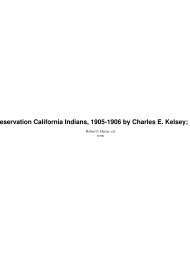Yosemite Online
Yosemite Online
Yosemite Online
You also want an ePaper? Increase the reach of your titles
YUMPU automatically turns print PDFs into web optimized ePapers that Google loves.
YOSEMITEJANUARY, 1979 VOLUME FORTY-SEVEN, NUMBER 5Published for members of <strong>Yosemite</strong> Natural History AssociationYOSEMITEVALLEYSCALE : 1 :15,840J .F .M . 78A. LOWER CHAMBER F . INDIAN CREEK K . SENTINEL CREEKB. CENTRAL CHAMBER G . YOSEMITE CREEK L . ILLILOUTTE CREEKC. UPPER CHAMBER H . RIBBON CREEK M . MEDIAL MORAINED. MERCED RIVER I . FIREPLACE CREEK N . EL CAPITAN MORAINEE. TENAYA CREEK J . BRIDALVEIL CREEK<strong>Yosemite</strong> Valley's Forgotten Natural Process: The Stream SystemYOSEMITE VALLEY'S STREAM SYSTEM IS UNIQUE . Where else in the world do waterfalls orcascades like the <strong>Yosemite</strong>, Nevada, Vernal, Bridalveil, Ribbon, Staircase or Tenaya pour overmassive granite cliffs, down through narrow gorges to feed a stream system which lies on analmost level valley floor of huge meadows and encroaching forest of oak, pine, and cedar?The Merced River has flowed through <strong>Yosemite</strong> Valley for thousands of years, even beforethe time of the glacial advances which were responsible for creating these famous landformfeatures which hang on the Valley walls today . Following the glacial retreat some ten thousandyears ago, the pristine aboriginal streams of <strong>Yosemite</strong> Valley had the appearance of adynamic system . Rapidly eroding stream banks sloughing off into the shallow stream channel,the streams transporting the alluvium , between the numerous mid-channel islands and eventuallydepositing them on the point bars 2 or one of the many timber debris jams . Huge underminedBlack Oaks and Alders could be seen hanging over steep stream bank providing coolshade which oxbows and low lying meadow lands flooded with backwater, built up behindthe El Capital Moraine . All these features of the riverian environment contributed to the creationof the Valley floor as it was seen during the time of white discovery in 1851.Since the retreat of the <strong>Yosemite</strong> Glaciers, the stream system of the Valley has passedthrough a sequence of orderly events . A summary of the events which led to the formation ofthe Valley's stream system in 1851, is as follows:STAGE ONE : Filling of Ancient Lake <strong>Yosemite</strong>.Fed by the Tioga and Tenaya stage glaciers, Tenaya Creek and the Merced River were mainlyresponsible for the filling in of the ancient lake basin in the Central Chamber . Throughcoalescing of the streams and expanding deltas, a continuous plain of stream sediments eventuallyfilled the ancient lake to the crest of the El Capitan Moraine.
PAST STREAM CHARACTERISTICSYOSEMITE VALLEYSINUOUS MEANDERING BRAIDEDSTAGE TWO STAGE THREE STAGE FOURSTAGE TWO : The Merced River a Sinuous Channel.Throughout a relatively short period of time, a series of breaches in the moraine damstimulated stream rejuvenation . The river cut down through the old delta plain some fifteenfeet. This caused a change in channel morphology' . The Merced River now devoted most ofits energy to vertical erosion and as a result its sinuosity decreased . The Merced Riverdeveloped a large gently curving channel, made up of long straight reaches.STAGE THREE : The Merced River, a Meandering Stream.As the Merced River approached its new base level, stream sinuousity increased since a lowergradient had developed . The river slowly began to evolve from a sinuous channel 4 to ameandering channel s. Stream degradation (down cutting) still occurred, however, lateralmigration of the river flourished . During this fluvially active period the final stages of the newfloodplain construction were completed.STAGE FOUR : Braided Stream & Patterns Develop.The Merced River, not able to down cut any further since large boulders blocked the rivergap in the Moraine dam, could only migrate laterally . Sediments from accelerating bank erosionin addition to annual flood deposits, overwhelmed the stream's capacity to transport,resulting in a shift in channel morphology from a meandering stream to predominantlybraided channel conditions. In many locations, the river spread out and divided by formingmid-channel point bars composed of alluvial sand and gravel . This condition existed in thelower four of the five and one-half miles of the Central Chamber . This change in channelmorphology coincides with the coming of modern man to <strong>Yosemite</strong> Valley in 1851.For the next twenty-eight years <strong>Yosemite</strong> Valley maintained a natural riverscape appearance.One of the most noticeable conditions were the swampy meadow lands which existed in thelower end of the Central Chamber . The combination of permanent rock dams formed byglacial moraines and the numerous log-jams found throughout the natural riverscape werelargely responsible for contributing to swampy meadow conditions . The most important andpermanent cause of the swampy meadows on the Valley floor was the El Capital Moraine.This landform left by the glacial advances, controlled the base level of erosion and influencedsurface water drainage.It was not until 1879 that the stream system was seriously disturbed by modern man . An earlyguardian of <strong>Yosemite</strong> Valley named Galen Clark, succeeded to alter the elevation of thebase-level, lowered the water table, increased surface drainage and initiated channel degradationin the Central Chamber . Early accounts of <strong>Yosemite</strong> Valley describe the meadow landsas being swampy . Galen Clark realized the influence of the El Capital Moraine on thehydrology of the Central Chamber . In an attempt to open potential grazing land, and accessto various areas of the Valley, Clark, in 1879, found a quick and sure method of draining thelow lying meadows. The following letter written by Clark in 1907, titled "Cause of SwiftErosion," describes the incident.It may be interesting to the public to know the cause of there being in recent years so much moreactivity in the river currents cutting away the river banks than during the earlier known history of
<strong>Yosemite</strong>. When the El Capital bridge was built in 1879, it was located across the narrow channel ofthe river between the two points of what remains of an old glacial terminal moraine.The river channel at this place was filled with large boulders, which greatly obstructed the freeoutflow of the flood waters in the spring, causing extensive overflows of the low meadow landabove, greatly interfering with travel, especially to <strong>Yosemite</strong> Falls and Mirror Lake. In order toremedy this matter, the large boulders in the river channel were blasted and the fragments leveleddown so as to give a free outflow of the flood waters. This increased the flow of the river currents,which now commenced greater eroding work on the river banks, and as the winding turns becamemore abrupt the destructive force annually increases. Some thorough system of protection should bepromptly used to save the river banks from further damage.A detailed study of the El Capitan Moraine dam was completed during the Fall of 1977 . Takingadvantage of the low water during this drought year, the observations revealed the locationof where Galen Clark blasted the moraine boulders in order to increase surface drainageand lower the water table . The study determined the width, length and depth of the blastedarea. By measuring boulder fragments, tributary stream terrace levels, conifer hierarchy' onthe stream terrace levels and surveying of six cross-sections of the Valley floor, the originalheight of the El Capitan Moraine prior to the blasting was determined . Since 1879, tributarystream channels have down-cut to an average depth of 4 .5 feet. This means that the presentriver gap in the El Capitan Moraine must be 4 .5 lower than in 1879 prior to Clark's blasting.This figure is important because the river-gap elevation represents the base-level of erosionfor the entire Central Chamber . Since 1879, the stream system's accelerated rate of degradationabove the moraine has remained unchecked.Photographs taken of <strong>Yosemite</strong> Valley by Watkins and Fiske in 1866, fifteen years before theEl Capitan Moraine was blasted, show photo after photo of heavily eroded stream banks fiveto six feet high, undermining trees and exposing roots of tall pines, cedars and oaks.Throughout geologic time, <strong>Yosemite</strong> Valley's stream system in the Central Chamber repeatedlyshifted its channel . Oxbow bends, abandoned stream channels and sloughs scar thefloors of every large meadow in <strong>Yosemite</strong> Valley . Swampy meadows developed in the depressionsof the fluvial scars . Stream bank erosion was as much a part of the aboriginal landscapein <strong>Yosemite</strong> Valley as the waterfalls.Despite the fact that the processes of lateral erosion were normal, early guardians and themanaging Board of Commissioners for <strong>Yosemite</strong> saw this natural phenomena as destructive to<strong>Yosemite</strong> meadows . In all actuality, no one noticed the river's dynamic character until itbegan to undermine bridges, roads and lodges constructed in the meander belt of the streamsystem . Galen Clark had begun the campaign of altering the pristine aboriginal riverscapeby rejuvenating stream degradation, while the Commission sought methods to halt lateralerosion.In 1882, the State Engineer, W . Hall, visited <strong>Yosemite</strong> Valley and inspected the river systemto suggest improvements at the Commissioners request. The following quotes are from hispamphlet, "To preserve from defacement and promote use of the <strong>Yosemite</strong> Valley" (1882).The following quotations document that braided reaches of channel existed and thatnumerous amounts of logs and unchecked lateral erosion were natural features in theriverscape.. . several notable obstructions lay in the river channel. Waters must be brought into one channel.. . above the Upper Iron Bridge, I found the river channel to be in especially bad condition, in fact,it divided up, spread out, obstructed and torturous in its course . . . result in unregulated overflow oflarge portions of available meadow lands in the Valley.. the streams of the Valley must be cleared and regulated.. Rivers are constantly demolishing their banks at some points and building up in others.From the above quotations one can get a good physical description of the river's behavior.Lateral erosion was very evident and was augmented by natural debris in the stream.Beginning in the early 1880's modern man installed the first physical amorment to protect thestream banks from eroding . Large granite boulders called rip-rap revetments are strategicallyplaced to cover entire sections of river bank subject to stream erosion . This type of armor requiresthousands of cubic yards of granite rock.In the fall of 1977, the first complete inventory of all artificial structures found in theriverscape of <strong>Yosemite</strong> Valley was completed.The total length of every rip-rap revetment site found in <strong>Yosemite</strong> Valley stream system wasmeasured. The total length came to 14,518 feet . To clarify the magnitude of this figure imagineturning the length vertically with the base at sea level . Comparing such a stack ofrevetment stones to the height of Mount Whitney leaves a tower of rip-rap some twenty-twofeet above the mountain top .
Having installed this mammoth amount of granite boulders along the eroding river banks ofthe stream system, the source of alluvium required to maintain the original braided channelswas cut off. Combined with Galen Clark's blasting of the El Capitan Moraine, which resultedin the present down-cutting of the stream, the channel in most locations has been narrowed.As seen by the evidence presented here, there have been many changes to the stream systemof <strong>Yosemite</strong> Valley in the last one hundred years . Unfortunately, most of these changes whichhave produced the present day stream system are a product of man's manipulation of thenatural stream system.Had modern man not observed the natural stream processes as a destructive process and insteadrecognized this process as being responsible for creating the present topography of theValley floor, then one could, to this day, visit <strong>Yosemite</strong> Valley and view a pristine aboriginal_riverscape.Alas, we are left with a river of which many reaches are artificially controlled, with sectionsof river bank sloped by machine, armored with tons of rip-rap revetment and with a channelchoked with constricting bridges and pipe dams . The irony of such a dilemma is that these artificialcontrols are found within the heart of a great National Park. We should take a closerlook at means of protection for the pristine aboriginal environments within <strong>Yosemite</strong> Valleyfrom such human ravages .James F . MilestoneI am indebted to Dr. Rene Barendregt and to William Milestone for their constructive criticism and directionduring the writing of this paper.OPERATIONAL DEFINITIONS1 . ALLUVIUM: Stream sediment deposits laid down in river channels by the process oferosion.2. POINT-BAR : Sediment deposited on the inside of a growing meander loop.3. CHANNEL MORPHOLOGY : The form, structure and pattern of a stream channel.4. SINUOUS STREAM : A channel made of long straight reaches with slight curvature in its patterndeterminted by the ratio of channel length to valley length.5 . MEANDERING STREAM: Characteristic habit of mature rivers described as winding freely ona broad flood plain with some degree of symmetry to the curvature . Determined by theratio of channel length to valley length.6. BRAIDED STREAM : Braided stream is one flowing in several dividing and reuniting channelsresembling the strands of a braid, the cause of division being the obstruction by sedimentdeposited by the stream.7. CONIFER HIERARCHY : Describes the age of conifer growth in relation to stream terrace levelsdetermining the relative age of the stream terraces .
REFERENCESClark, G . (1907) Cause of Swift Erosion ; <strong>Yosemite</strong> Nature Notes, Vol . VI, No . 2-2-27.Commissioners (1877-1904) Commissioners to Manage <strong>Yosemite</strong> Valley and the Mariposa Big TreeGrove ; Biennial Report, California State Printing Office.Hall, Wm . Ham (1882) To preserve from defacement and promote use of the <strong>Yosemite</strong> Valley . Report ofState Engineer; California State Printing Office.Matthes, Francois E . (1930) Geologic History of the <strong>Yosemite</strong> Valley. U .S. Geological Survey of ProfessionalPaper, p . 160.Milestone, J .F . (1978) Influence of Modern Man on the Stream System of <strong>Yosemite</strong> Valley; S .F . S .U.Master Thesis ; Geography Department.Schaffer, Jeffrey (1977) Glacial History of <strong>Yosemite</strong> Valley - California Geology.The preceding article was written and illustrated by James Milestone for YNHA . Since 1973, he has workedas a volunteer naturalist in <strong>Yosemite</strong> and at Fort Cronkhite, as an interpreter at Alcatraz Island, and a backcountryranger at Mt. Rainier NP, a park technician at Stinson Beach and Marin Headlands, (parts of theGolden Gate National Recreation Area), a physical science technician at Redwoods NP and a work projectcoordinator for the Youth Conservation Corps . He has his Masters degree in physical geology from SanFrancisco State University. He's twenty-four years old and we predict that if he keeps as busy in the futureas he has in the past five years, he's headed for success.Enclosed is the 1979 summer seminar catalog — hot off the presses!Of special note are a few new classes that have been added.Botany for Beginners — A course designed for those who areinterested in botany, but have never had any formal botanical orecological training. An ideal preparation for the traditional alpine andsubalpine botany classes . Spring Botany Weekends — Carl Sharsmithis back on the YNHA staff again this year and will be teaching twoweekend botany classes in addition to alpine botany in the summer.The foothills should be EXPLODING with flowers in the spring — anexcellent opportunity for serious student and amateur alike.Subalpine Botany For Backpackers — Bob Fry will be leading a subalpine botany course thissummer that will take place entirely in the backcountry of <strong>Yosemite</strong> . Each day the lecturearea will be in a different place, with the participants camping out at night in the LyellCanyon, Townsley Lake, Vogelsang Lake, and Rafferty Creek. This is a good opportunity tostudy botany in various subalpine areas of the park. This should be a popular course — sosign up early if you are interested . Paint <strong>Yosemite</strong> is being offered again this year . Bring alongwater colors, oils, pastels, and charcoals, and join Jane Gyer in an artistic exploration of<strong>Yosemite</strong> Valley. If you are artistic but don't feel like 'roughing it' in <strong>Yosemite</strong>, YNHA hasreserved a small block of rooms for the participants of this course.Bob Fry is offering an Advanced Ethnobotany course for all those who feel that they wouldlike to delve a little further into the things they studied in Ethnobotany . The course willprovide opportunities for 'hands on' activities and there will be field trips into severaldifferent areas .WINTER TRIPS — Members have received the announcement of ourwinter programs . Predictably, Carl Sharsmith's ecology classes filledpromptly.We trust that we'll have a good share of members among those onthe Ostrander Lake Ski trips and on the Trans-Sierra trips . We findfew experiences as rewarding as a trek through the winter woods.While we do a good deal of huffing and puffing and occasionallyfind ourselves hung up in a manzanita bush — we put it all down aspart of the fun . Then, when there's a chance for a long stretch ofdownhill, the agonies disappear. Perhaps best, though, is the quietthat seems to accompany winter in the forest . One's skis may scrunch a little andoccasionally snow plops from a branch . But mostly, it's soundless. Ski touring may not beeveryone's idea of heaven, but in our book it beats the pants off jogging!The Trans-Sierra trip, though covering a total of 50 miles, is done in comparatively easystages, eight miles being the longest . Plainly, it's not for beginners but, on the other hand, it'snot like climbing McKinley . And the sight of all the fabulous Tuolumne landscape — undersnow — is difficult to compare.The Ostrander Trips are April 7-9 and April 21-23 ; the Trans-Sierra Trips are March 18-24 andMarch 25-31 . If you're interested but have lost the little blue folder, let us know .
DANA MORGENSON RE-ELECTED TO BOARD . Mr. DanaMorgenson, who has served on YNHA's Board of Trustees since 1946and as its Chairman since 1973, was re-elected by the membership toa six year term. Also running for the vacancy was Mr . Ken Salzberg, aSouthern California attorney . Mr. Salzberg presented his nominationpetition at the September member's meeting.We mailed 1,075 ballots to members on November 14 . According toYNHA By-Laws, these were to be returned by December 15. A tally atthe close of that day showed that 364 were returned ; 261 votes forMorgenson; 94 for Salzberg ; one write-in vote for Jack Walston, oneblank ballot; one on which votes were cast for both nominees ; seven received after thedeadline.The association wishes to thank Mr . Salzberg for his interest in the organization as evidencedby his placing his name in nomination ; we hope that his interest will continue.At its January 27 meeting, the Board will elect its chairman.With Mr . Morgenson's re-election to the Board of Trustees, there now is a full complement ofseven voting members, plus a National Park Service representative, a non-voting member.Under the terms of the Cooperating Association Agreement (with NPS) the National ParkService Board member may not vote but he/she may participate in discussions andoffer counsel, except in connection with matters that pertain to the distribution of YNHAfunds to NPS.Here are the people who direct the policies of your association.DANA C . MORGENSON : Education_ Degrees from University of Pacific, Stockton, CA ; Stanford University . Currently,Director of Guest Relations, <strong>Yosemite</strong> Park and Curry Co . On YNHA Board of Trustees since 1946 ; Chairman,1973-present . Mr . Morgenson is author and illustrator (photos) of YOSEMITE WILDFLOWER TRAILS published by YNHAand "Four Seasons of <strong>Yosemite</strong>," published by the <strong>Yosemite</strong> Park and Curry Co - He leads the popular "Camera Walks"for YPCCo . and had directed seminars on "Photography for the Botanist" for YNHA.STERLING S. CRAMER : Education. A .B . Degree from Stanford University ; M .B .A . from Graduate School of Business,Stanford University . Vice President Finance and Treasurer for the <strong>Yosemite</strong> Park and Curry Co . from 1935-1969: presentlyAccounting and Management Consultant for the Fontana East Apartment Corporation, San Francisco . Member of theMariposa County Planning Commission ; California Olympic Commission ; California State Park Commission ; InternationalExecutive Service Corps (Indonesia); Citizens Advisory Trails Committee at Golden Gate National RecreationArea . Mr . Cramer has been a member of the <strong>Yosemite</strong> Natural History Association Board of Trustees since 1942 . He andhis wife are frequent park visitors, skiing in winter and hiking in summer.LEWIS S . EATON : Graduate of Stanford University ; served in World War II from 1942 to 1946. President of GuaranteeSavings and Loan Association since 1956 . Mr. Eaton has been active as President of the Fresno City Board of Educationfrom 1959 to 1962 ; President of the Fresno County-City Chamber of Commerce in 1967 ; Trustees of Fresno CommunityHospital since 1965 ; Chairman of the Board of Governors, Fresno Regional Foundation since 1966 ; Trustees of the CaliforniaMuseum Foundation since 1971 ; President of the Stanford Alumni Association 1975-76 ; Chairman of the NationalParks Advisory Board, Western Region 1972 to 1978.MRS . MICHAEL (JEANNE FALK) ADAMS : Has studied at San Francisco State University, University of Munich, FresnoState, University of Colorado Language Institute, and Stanford University . Mrs . Adams has a Secondary Teaching Certificatein Social Studies . Taught high school in Fresno, St . Louis, and Bitburg, Germany . Chaired Fresno HousingManagement Task Force, and lectured at California State University, Fresno ; Vice President of The Ansel Adams Gallery.FREDERICK HARPER, D .D .S .: Graduate of University of Southern California, Master of Science and Doctor of DentalSurgery, University of Southern California School of Dentistry . Served in United. States Army Dental Corps in West Germany. In general practice of dentistry in Los Angeles . Editor, The Western Dental Society Bulletin ; Fellow, InternationalCollege of Dentists; President, Westwood Academy of Medicine and Dentistry . Associate Clinical Professor, School ofDentistry, University of Southern California ; Essayist Western Dental Society . Dr . Harper is active in Southern CaliforniaRed Cross, Boy Scouts, United Way, and Chamber of Commerce organizations . He reports that his particular nonprofessionalinterests lie in the natural history of the Sierra Nevada, backpacking and climbing, and cross-country skiing.THOMAS J. SHEPHARD : Education : A .B . Degree from U .C . Berkeley; J .D . from UC Berkeley . Mr . Shephard has been onthe Legislative Counsel ; Deputy County Counsel, San Joaquin County; and Attorney with the San Joaquin County FloodControl and Water Conservation District . He is presently a partner in the firm of Neumiller & Beardslee, Stockton . He isalso the General Counsel for the Stockton-East Water District; Attorney for Stanislaus River Flood Control Association.He has been a member of the Board of Trustees of the <strong>Yosemite</strong> Natural History Association since 1974 and the Vice-Chairman of the Board since 1978 . He is on the Board of Trustees at St. Joseph's Hospital, Stockton ; member of theBoard of St. Mary's High School, Stockton ; Vice-President, University of California Berkeley Alumni Association ; PastPresident of the Greater Stockton Chamber of Commerce, the San Joaquin County Board of Education, and CatholicCharities of the Diocese of Stockton .
LESLIE P . ARNBERGER : Education : B.S ., Arizona State College, Flagstaff, AL Mr . Arnberger served in the U .S . Army AirCorps from 1944-1945 . He began working for the National Park Service in 1945 at Grand Canyon National Park . He wastransferred to Casa Grande in 1948 ; Southwest National Monuments in 1950 ; Blue Ridge Parkway in 1955 ; Santa Fe in1956 ; and in 1965 he became the superintendent of Point Reyes National Seashore . Mr. Arnberger served in the OperationsDivision of the National Park Service in the Washington Office in 1967 . He was the superintendent of Cape Cod NationalSeashore from August 1968 until assigned to <strong>Yosemite</strong> National Park as the superintendent in 1974.DR . HARVEY B . RHODES: Education : Bachelor degrees in physical education and biological science, San Jose StateUniversity; M .S . biological science, USC ; PhD, higher education, UC Berkeley . Presently, President, Columbia College,Columbia, CA . Dr . Rhodes has had a distinguished career in educational fields . He was selected in 1967 as director of theyet to be built Columbia College, and its president in 1968, upon completion of the present school facility . Dc Rhodeshas held a host of positions in the field of education during his 32 year career and has served on numerous state andfederal boards and commissions treating many facets of education . He has been on the YNHA Board of Trustees since1974.NAMES AND MEANINGS FOR YOSEMITE VALLEY . Throughout the past 126 years, determiningthe true names and their meanings for <strong>Yosemite</strong> Valley has been a source of heateddebate. So much discussion and disagreement have taken place that today one is left confusedregarding the true meaning of "<strong>Yosemite</strong>" and "Ahwahnee ."When the Mariposa Battalion entered <strong>Yosemite</strong> Valley in 1851, the area was inhabited by Indiansthe soldiers called the "<strong>Yosemite</strong>s ." It was not until 1877 that Stephen Powers in hisTribes of California identified this as primarily a Miwok group . There was, to be sure, a greatnumber of Mono Lake Paiute people who had intermarried with the <strong>Yosemite</strong> Miwok, and itseems from ethnographic data that the Mono Lake Paiute tongue and a sub-dialect ofSouthern Miwok were spoken here concurrently.Lafayette Bunnell, a member of the Mariposa Battalion, stated that the meaning of the name<strong>Yosemite</strong> was not generally known when it was bestowed upon the Valley . Major JamesSavage, the Battalion's leader, told Bunnell that "Yo-sem-ity," as it was pronounced by ChiefTenaya, meant "full-grown Grizzly" (Bunnell, 1880, pp . 61-65).This description was incorporated into Bunnell's widely read book Discovery of the <strong>Yosemite</strong>.He also provided information which was the basis for several editorials included in theCalifornia Chronicle, the Sacramento Union, the Mariposa Gazette and other papers, whichprobably contributed to the widespread acceptance of this definition.Dr. A. L. Kroeber, the late dean of California anthropologists, writing in 1921, stated that<strong>Yosemite</strong> was a corruption of "uzumati" or "uhumati" meaning grizzly bear (Hall, 1921) . Hebased his thoughts on the fact that the Miwok had divided themselves into moieties : a clanlikesystem. Various animals belonged to the two moieties, and the grizzly bear was generallyidentified with members of the land moiety . Dr . C . Hart Merriam also agreed with this definition(1917, pp . 202-209). Yet, when one analyzes the term "<strong>Yosemite</strong>" linguistically, it takes ona different meaning.Although different ethnographers utilized various phonetic orthographies, the general pronunciationbecomes "Yo'hem-iteh,"coming from the stem verb "yohe," meaning to kill . The'miteh" portion is a collective plural suffix, thus the word "yo'hem-iteh" translates as "theyare killers" (Barrett, 1919, p . 28; Gudde, 1949, p. 395; Broadbent, 1969, op . cit).These definitions are based on direct contact with Southern Sierra Miwok people who spoketheir native language fluently . Very few such speakers remain today . One man remembersthat his mother said the term <strong>Yosemite</strong> had something to do with killers (personal contact,John Sensor).Though white visitors called the valley "<strong>Yosemite</strong>," the native Miwok people seem to haveused the term "Ahwahnee ." Bunnell states that he could not understand Chief Tenaya'slanguage . So, by means of signs, Tenaya attempted to indicate what "Ahwahnee" meant . Bunnellsays, "I inferred from these signs that it must mean the deep grassy valley," adding that"still, it may not mean that ." Others have quoted Bunnell's definition and have cast aside hiscautionary remark.When Ahwahnee is transcribed through linguistic orthography it becomes "?awo- .ni" [var.?owo- .ni] (Broadbent, 1969) . The stem word is seemingly "?awo" [var . ?owo .-J meaning mouth.Thus, "awo- .ni" becomes "the big mouth" or "place of the big mouth ."This interpretation has been available for some time, but seems to have been discarded forthe more romantic "deep, grassy valley ."In a 1933 National Geographic article on the <strong>Yosemite</strong> Valley we find the first mention of theword "Ahwahnee" interpreted to mean "big mouth ." A later reference appears in a letter writtenby a park naturalist in 1940 in which is stated : "However, Chief Lemee, one of our localIndians explained Ahwahnee as big mouth ."
Inquiry among native Miwok speakers today reveals little memory of the word . Those that doremember it recall it as a term for the <strong>Yosemite</strong> People (with addition of -che, meaning peopleof). They think that it may have something to do with the "place you go to pound acorn"or the "place you go and play" (perhaps from the stem "?aw .i" - play games, or "?aw .i?" - aplayground).The foregoing statements may serve only to further confuse the issue of the true meaning ofthe terms "<strong>Yosemite</strong>" and "Ahwahnee ." The discussion should help to point out that whensearching for the translation of a specific native American term, one can never be toocareful, nor ultimately correct .—Craig BatesREFERENCESBarrett, Samuel A ., MYTHS OF THE SOUTHERN SIERRA MIWOK . University of California Publications in AmericanArchaeology and Ethnology, Vol . 16, 1919.Broadbent, Sylvia M ., THE SOUTHERN SIERRA MIWOK LANGUAGE, University of California Publications inLinguistics, Vol. 68, 1964.Buehler, Karen, AHWAHNEE in "<strong>Yosemite</strong>,"" newsletter of the <strong>Yosemite</strong> Natural History Association, Vol . 43, #1,April, 1973.Bunnell, Lafayette H ., DISCOVERY OF THE YOSEMITE, 1880.Cudde . Irwin G ., CALIFORNIA PLACE NAMES, Uni versity of California Press, 1949Hall. Ansel F . . HANDBOOK OF YOSEMITE NATIONAL PARK, G .P . Putnams Sons, New York and London, 1921.Harwell, C . A . . Red Men and 1% hire in <strong>Yosemite</strong> Valley," Geographic News Bulletin, March 23, 1936.Merriam, C. Hart . INDIAN VILLAGE AND CAMP SITES IN' YOSEMITE VALLEY, Sierra Club Bulletin, Vol . 10,pp 202-209, 1917Powers . Stephen . TRIBES OF CALIFORNIA, 1877.My thanks to: Dr . Sylvia Broadbent, University of California, RiversideAgnes Castro, Miwok and Paiute, MariposaThe late Mary Cox, Northern MiwokJohn Sensor, Columbia Junior CollegeDorothy Stanley, Northern MiwokNEW MEMBERS .We welcome to membership in Y .N .H .A. the following good people.John Jackson James Sims Susan Smith The Abbott FamilyWilliam Riddle Kathy Watanabe L .E . Henricks The Cronin FamilyDaniel Baker Joyce Treu Mr . & Mrs . A . Chasteen Malcolm ClarkMrs . B . Janik William Todd Joe Choelwa Dr . & Mrs . Conroy-LappinStacey Dematteis Marjory Beamish Barbar Gallarda Greg FauthJim Bullock Hope Burla James Patterson Patrick RobertsRichard Hall Christian Kilkka George Crane Melva HahnBob Murphy Philip Nice Tim Jensen Betty GoodrichLeadership Wilderness CO . Helen Bradfield Paula Negley Carol KippsGeorge Kaminski Donna Miguelgorry (L) Jean Drayer Margaret JenkinsLucy Ash Neva Snell (L) Hilary Karp John VoeksDean & Mary Shenk Marie Herbert Virginia Stoddart Doug Walker (L)Mrs . O . Whittlesey T & B Sarment C & M Jones Kenny KramerBennett Tow Nancy Cockran Anthony Jones Stan & Judy HeydrickLakeview Motel Trevelyan Houck Curtis Jones R . Dickson YeagerHarry Namitz Robert Cook Richard Wilkins James MilestoneMadelyn Miller Dennis Corcoran Charlie Sauer Sheldon AmesJennifer O'Hara Randa Diamond Bruce Montgomery Keith KunhardtKaren Hart Helen Alfredson Susan Hunter Cynthia SartorDonald Browne Lawrance Brown Nina Kelly Kathy MillerChris T . Wong Steve Cochrane Linda Yemoto (L) Virginia DuncanWilliam Wernet Ginger Springer Louise Addis Diane BeckMarvin Rosenberg Maryanne Flett Emily Stover. Brian & Lani StromHolly Rucker Keith Peterson Gertrude Sturgeon Clark MagruderGary Martin Joan Barker Mark Youngdahl Frank FaulknerCharles Knoth Meredith Reeve Barbara Clites Mark De WettD & A Lange Jeffrey Keay Larry Perkins Marcy BurksDr . & Mrs . D . Ostrander Dick & Viki Ashford Clarence Baker Ruth StorrPhilip Solter Henry Althoen Sally Stockwell John Burgis (L)Sven Newman Susan Voss William Clark, M .D . Howard WurlitzerJoel Gruber William Murray E & M Schultz Herbert Cantelow (L)Nancy Kamalski William B . Cella James Rowen Dr. David Korchek (L)Joe Norman (L)
Digitized by<strong>Yosemite</strong> <strong>Online</strong> Libraryhttp ://www .yosemite .ca .us/libraryDan Anderson




![(March 1982) [PDF] “We Are Pleased to Announce†- Yosemite Online](https://img.yumpu.com/51299748/1/190x242/march-1982-pdf-aeuroewe-are-pleased-to-announceaeur-yosemite-online.jpg?quality=85)
![[PDF] Old Horny, Yosemite's Unicorn Buck - Yosemite Online](https://img.yumpu.com/51269869/1/184x260/pdf-old-horny-yosemites-unicorn-buck-yosemite-online.jpg?quality=85)
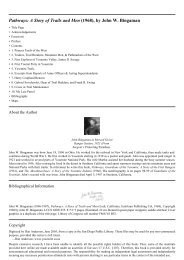
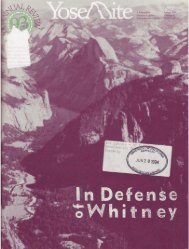
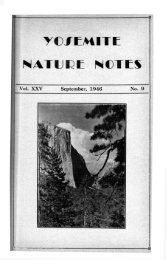
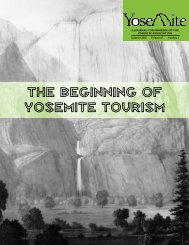
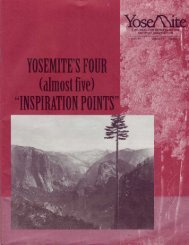
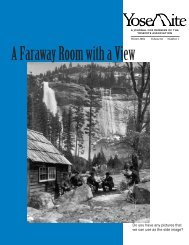
![1985 [PDF] - Yosemite](https://img.yumpu.com/48128837/1/184x260/1985-pdf-yosemite.jpg?quality=85)

